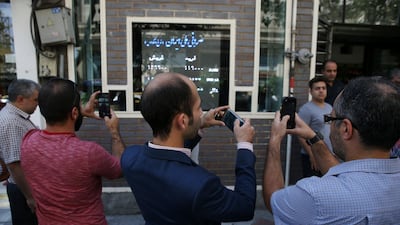Iran's Inflation is set to rise in the months ahead as the November deadline to re-impose full US sanctions nears, leading to a slump in exports and investment, and fuelling further depreciation of the currency, according to a new report.
Fitch Solutions, a unit of the Fitch Group, has forecast inflation will average 33.2 per cent in the 2018-2019 financial year that started in April, up from its previous forecast of 17 per cent. In the previous financial year, inflation hit 9.7 per cent.
"The full re-imposition of US sanctions in November 2018 will reduce Iranian exports and investment inflows, and constrain cross-border financial transactions," Fitch Solutions said. "In turn, this will restrict foreign currency availability and fuel rial depreciation, making imports more costly."
Iran's rial has hit multiple record lows this year against the US dollar, dragged down by the worsening state of the nation’s economy and the re-imposition of sanctions by US over its nuclear programme. The demand for dollar is stoked by concerns that the impact of US sanctions would be felt beyond the country’s crude shipments and will affect Iran’s broader export sector.
_______________
Read more:
Iran central bank authorised to intervene in foreign exchange market to defend rial
Mike Pompeo heads talks to counter 'malign' Iran
US to close consulate in Basra over Iran security risk
_______________
The rising cost of living has led to public dissent and mass protests that were held in several Iranian cities earlier this year.
Further contributing to price growth will be the continued expansion of Iran’s monetary base, according to the report.
“Money supply growth has historically been high in the country, in large part due to monetisation of public debt. We remain sceptical of the authorities’ ability to implement structural reforms in the current political climate,” the report said. “We view major fiscal reforms as unlikely. The central government will be reluctant to implement austerity measures in the face of rising popular discontent.”
The fiscal deficit in Iran will likely widen, and much of it will be covered through borrowing from the banking sector, fuelling money supply growth. Any forthcoming banking sector reforms are not expected to prove far-reaching enough to substantially increase central bank independence and supervision either.
“Consequently, many Iranian banks and credit institutions will likely continue their unsustainable lending practices, further increasing liquidity,” the report added.


